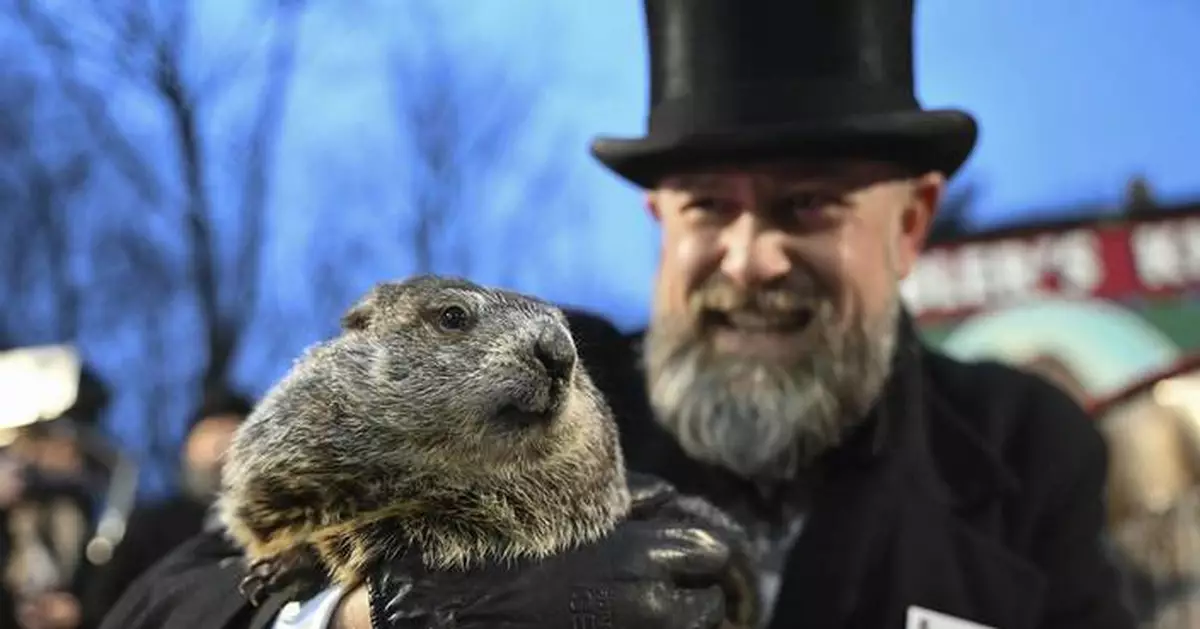Now we know what Punxsutawney Phil, the groundhog who predicts whether an early spring will arrive each Feb. 2, does on the other 364 days.
The Pennsylvania group that handles Phil, and his groundhog wife, Phyllis, says the couple have become parents.
The Punxsutawney Groundhog Club said in a Facebook post Wednesday that Phyllis recently gave birth to two healthy babies. It did not specify their sex or give names for either one.
“We’re pleased to announce that Punxsutawney Phil has had his first children; we believe there are two baby groundhogs and that Phil and Phyllis have started a family,” Thomas Dunkel, president of a tuxedo-clad group called The Inner Circle that carries on the groundhog tradition each year, said at a news conference Wednesday. “We’re pleased about it, and I talked to Phil with my cane, which lets me speak Groundhogese, and Phil could not be more excited that he started a family.”
Dunkel said a club member discovered the babies Saturday when he came to feed their parents fruit and vegetables.
Phil emerges from his burrow each year the morning of Feb. 2. If he sees his shadow, tradition holds, there will be six more weeks of winter. This year, he did not see his shadow, heralding an early spring.
Although the best known, Phil is far from the only groundhog to try his hand at meteorology. There have been weather-predicting groundhogs in at least 28 U.S. states and Canadian provinces, and less formal celebrations far and wide.
Phil and Phyllis live in climate-controlled quarters at the Punxsutawney Memorial Library.
But like most growing families, they now need larger digs. The club plans to move them to a larger home on the library's grounds.
Like Santa Claus and the Easter Bunny, Punxsutawney Phil comes with his own mythology, including the claim that he will live forever, due to imbibing some magic juice called “The Elixir Of Life.” (His wife is not allowed to partake of the elixir, and thus, is not immortal. Where are groundhog suffragettes when they're truly needed?)
Given that the annual Groundhog Day ritual has been performed since 1887, that would place Phil in his late 130s, a procreational feat that puts Al Pacino, Robert De Niro and Mick Jagger to shame.
And what about the kids? Will they someday inherit the responsibility of predicting whether there will be six more weeks of winter? Will they have to spend their lives waiting for dad to shuffle off to that big burrow in the sky before they can inherit the throne?
Alas, no, Dunkel says. Because their father is immortal, there will always be only one of him.
Follow Wayne Parry on X at www.twitter.com/WayneParryAC

FILE - Groundhog Club handler A.J. Dereume holds Punxsutawney Phil, the weather prognosticating groundhog, during the 138th celebration of Groundhog Day on Gobbler's Knob in Punxsutawney, Pa., Friday, Feb. 2, 2024. The Punxsutawney Groundhog Club announced that Phil and his wife Phyliss, have become parents of two groundhog babies on Wednesday, March 27. Phil is credited by many with predicting whether an early spring is coming based on whether he sees his shadow on Feb. 2 each year. (AP Photo/Barry Reeger, File)

FILE - Groundhog Club handler A.J. Dereume holds Punxsutawney Phil, the weather prognosticating groundhog, during the 138th celebration of Groundhog Day on Gobbler's Knob in Punxsutawney, Pa., Friday, Feb. 2, 2024. The Punxsutawney Groundhog Club announced that Phil and his wife Phyliss, have become parents of two groundhog babies on Wednesday, March 27. Phil is credited by many with predicting whether an early spring is coming based on whether he sees his shadow on Feb. 2 each year. (AP Photo/Barry Reeger, File)
JACUMÉ, México (AP) — Near the towering border wall flanked by a U.S. Border Patrol vehicle, botanist Sula Vanderplank heard a quail in the scrub yelp “chi-ca-go,” a sound the birds use to signal they are separated from a mate or group.
Then silence.
A quail on the Mexican side called back, triggering a back-and-forth soundtrack that was both fitting and heartbreaking in an ecosystem split by an artificial barrier.
Vanderplank was among several botanists and citizen scientists participating in the Border Bioblitz near the Mexican community of Jacumé, about 60 miles (100 kilometers) east of Tijuana.
Roughly 1,000 volunteers armed with the iNaturalist app on their smartphones are documenting as many species as possible along the U.S.-Mexico border in May. Uploading photos to the app helps identify plants and animals, and records the coordinates of the location.
The hope is the information could lead to more protections for the region's natural richness, which is overshadowed by news of drug trafficking and migrant smuggling.
On a recent day, Bioblitz volunteers scrutinized a bright yellow blooming carpet of common Goldfields, a sharp contrast to the imposing steel bollards of the border wall topped with rolls of razor wire. Some navigated their way around piles of empty water jugs, a gray hoodie and empty cans of tuna fish left under the branches of native flora like the Tecate Cypress.
“There’s a fabulous amount of biodiversity here that’s traditionally been overlooked,” Vanderplank, of the binational program Baja Rare, said.
The efforts started in response to former President Donald Trump adding hundreds of miles of border walls that toppled untold numbers of saguaro cactuses in Arizona and passed through the biodiversity hotspot of Baja California.
“When the border wall construction began, we realized how little hard data we had, especially when it came to plants and small organisms,” Vanderplank said. “We don’t know what all we could lose.”
Since then, there has been a groundswell of initiatives to document the borderland’s flora and fauna as climate change coupled with habitat loss, pollution and development have hammered the world’s biodiversity. One estimate in 2019 warns that a million plant and animal species face extinction within decades, a rate of loss 1,000 times greater than expected.
The United Nations is expected hold a high-level meeting in Colombia of signatories to the Convention on Biological Diversity in October aiming to protect 30% of land, freshwater and oceans considered important for biodiversity by 2030, known as 30 by 30. Representatives from nearly 200 countries are expected to present plans on how they will meet conservation targets agreed upon in 2022.
Currently, 17% of terrestrial and 10% of marine areas are protected.
Baja California peninsula, which borders California and is home to Tijuana with one of Mexico's highest homicide rates, has more than 4,000 species of plants. A quarter of them are endemic and at least 400 plants are considered rare with little to no protection.
Flora and fauna that have gone extinct or are in danger of disappearing in the U.S., like the California red-legged frog, are thriving south of the border, producing specimens that are being used to bring back populations.
But the region’s crime deters many U.S. scientists from crossing the border. Mexico also is restricting permits for botanists and not allowing seeds to be collected, further curtailing the work, scientists say.
Bioblitz organizers work with local communities and say they take people only to areas deemed safe.
“You have to be really careful because of the violence,” said Jon Rebman, a curator of botany at the San Diego Natural History Museum, who has named 33 new plants for science from the southern California and Baja California region.
“It’s scary from that standpoint, yet those are the areas where we really need more information because there’s hardly any protected area on the south side,” he said.
Using the museum’s collection, Rebman made a list of 15 plant species endemic to Baja California and not seen since being collected nearly a century ago. He created a binational team to find them. So far, they have located 11.
Rebman also discovered two new plants to science in 2021 in a canyon off a Tijuana highway: the new species, Astragalus tijuanensis, and a new variety of the Astragalus brauntonii named lativexillum.
“I was worried they would go extinct before we even got them named,” Rebman said. “That tells you what type of area we’re working in.”
Tijuana-based botanist Mariana Fernandez of Expediciones Botánicas periodically checks on the plants. Working with Rebman, she is pushing Baja California to adopt more protections for its native plants. Currently only a fraction are on Mexico’s federal protection list.
She hopes the state will step in, while she also tries to build support by taking Tijuana residents and Baja officials on hikes.
“People are amazed that these things exist in Tijuana, and I hope to show more and more people so they can see the beauty, because we need that,” Fernandez said. “It’s important to not be impeded by the barriers that humans create.”
As border security increases with the number of people being displaced by natural disasters, violence and wars at record levels worldwide, more migrants are traipsing out to areas like the stretch near Jacumé. The tiny community of about 100 families includes members of the Kumeyaay tribe and sits across the border from an equally sparsely populated desert near the California town of Jacumba Hot Springs. Population: about 1,000.
The area has seen thousands of asylum seekers who wait for an opportunity to cross, usually in the cloak of darkness, and then camp again on the U.S. side after turning themselves in to U.S. Border Patrol agents.
Fernandez was among the botanists helping Bioblitz volunteers on the Mexican side near a crumbling crossing station from the 1920s.
“I never would have thought that there would be so much biodiversity on the border,” said Jocelyn Reyes, a student of Fernandez at La Universidad Autónoma de Baja California who stopped every few feet to hover over a plant and photograph its details. “It’s so interesting and makes you realize there’s so much worth saving.”

A California Horned Lizard is temporary held for classification during a botanical expedition with Universidad Autonoma de Baja California college students documenting native plants and species along the U.S.-Mexico border on Friday, April 19, 2024, in the Ejido Jacume in the Tecate Municipality of Baja California, Mexico. Botanists and citizen scientists armed with the iNaturalist app on their smartphones are recording the biodiversity along the U.S.-Mexico border in May. Called the Border Bioblitz, more than 1,000 volunteers are recording as many species as possible. (AP Photo/Damian Dovarganes)

Horses walk close to the US Mexico border Friday, April 19, 2024, in the Ejido Jacume in the Tecate Municipality of Baja California, Mexico. Botanists and citizen scientists armed with the iNaturalist app on their smartphones are recording the biodiversity along the U.S.-Mexico border in May. Called the Border Bioblitz, more than 1,000 volunteers are recording as many species as possible. (AP Photo/Damian Dovarganes)

Dr. Georges Seingier, Prof. Marine and Environmental Sciences at Baja California Autonomous University joins a botanical expedition with Universidad Autonoma de Baja California college students to document native plants along the U.S.- Mexico border on Friday, April 19, 2024, in the Ejido Jacume in the Tecate Municipality of Baja California, Mexico. The group near the Mexican community of Jacume, about (60 miles) 100 kilometers east of Tijuana, is one of several participating in the Border Bioblitz in which more than 1,000 volunteers throughout May record as many species as possible along the U.S.-Mexico border, a region plagued by drug trafficking and migrant smuggling that have overshadowed its natural richness. (AP Photo/Damian Dovarganes)

College students, members of Baja California's conservation organization Baja Rare, lead a botanical expedition to document native plants along the U.S.-Mexico border on Friday, April 19, 2024, in the Ejido Jacume in the Tecate municipality of Baja Calif., Mexico. The Baja California peninsula, which borders California and is home to Tijuana, one of the deadliest cities in the world, has more than 4,000 species of plants. According to scientists, a quarter of them are not found anywhere else, and some 200 plants are considered rare with little to no protection. (AP Photo/Damian Dovarganes)

A college student joins members of the California's Baja Rare conservation project leading a botanical expedition to document native plants along the U.S.- Mexico border on Friday, April 19, 2024, in the Ejido Jacume in the Tecate Municipality of Baja Calif., Mexico. Since then there has been a groundswell of initiatives to document the borderland's flora and fauna as climate change coupled with habitat loss, pollution and development have hammered the world's biodiversity, with one estimate in 2019 warning that a million plant and animal species face extinction within decades, a rate of loss 1,000 times greater than expected. (AP Photo/Damian Dovarganes)

Dr. Georges Seingier, Prof. Marine and Environmental Sciences at Baja California Autonomous University leads a botanical expedition with Universidad Autonoma de Baja California botanists and citizen scientists to document native plants along the U.S.- Mexico border on Friday, April 19, 2024, in the Ejido Jacume in the Tecate Municipality of Baja California, Mexico. Since then there has been a groundswell of initiatives to document the borderland's flora and fauna as climate change coupled with habitat loss, pollution and development have hammered the world's biodiversity, with one estimate in 2019 warning that a million plant and animal species face extinction within decades, a rate of loss 1,000 times greater than expected. (AP Photo/Damian Dovarganes)

Members of the Baja California's conservation Baja Rare project lead a botanical expedition with college students to document native plants along the U.S.-Mexico border on Friday, April 19, 2024, in the Ejido Jacume in the Tecate Municipality of Baja Calif., Mexico. The group near the Mexican community of Jacume, about (60 miles) 100 kilometers east of Tijuana, is one of several participating in the Border Bioblitz in which more than 1,000 volunteers throughout May record as many species as possible along the U.S.-Mexico border, a region plagued by drug trafficking and migrant smuggling that has overshadowed its natural richness. (AP Photo/Damian Dovarganes)

Lichen grows on native tree branches along the US-Mexico border on Friday, April 19, 2024, in the Ejido Jacume in the Tecate Municipality of Baja California, Mexico. Botanists and citizen scientists armed with the mobile cellphone iNaturalist app are recording the biodiversity along the U.S.-Mexico border in May. The Border Bioblitz has more than 1,000 volunteers recording as many species as possible. Flora and fauna that have gone extinct or are in danger of disappearing in the U.S. have been found to be thriving in remote spots south of the border, producing specimens that can then be used to bring back populations, scientists say. But the region's crime has deterred many U.S. scientists from crossing the border. (AP Photo/Damian Dovarganes)

Botanists and citizen scientists armed with the iNaturalist app on their smartphones record the biodiversity along the U.S.-Mexico border as bright yellow blooms carpet the ground, a sharp contrast to the imposing steel bollards of the border wall topped with rolls of razor wire as members of the California's Baja Rare project lead a botanical expedition with college students to document native plants along the US Mexico border on Friday, April 19, 2024, in the Ejido Jacume in the Tecate Municipality of Baja Calif., Mexico. (AP Photo/Damian Dovarganes)

Tijuana-based field botanist Mariana Fernandez of Expediciones Botanicas leads a botanical expedition with college students to document native plants along the U.S.- Mexico border on Friday, April 19, 2024, in the Ejido Jacume in the Tecate Municipality of Baja California, Mexico. Flora and fauna that have gone extinct or are in danger of disappearing in the U.S. have been found to be thriving in remote spots south of the border, producing specimens that can then be used to bring back populations, scientists say. But the region's crime has deterred many U.S. scientists from crossing the border. (AP Photo/Damian Dovarganes)

Botanists and citizen scientists armed with the iNaturalist app on their smartphones record the biodiversity along the U.S.-Mexico border as bright yellow blooms carpet the ground, a sharp contrast to the imposing steel bollards of the border wall topped with rolls of razor wire along the US Mexico border on Friday, April 19, 2024, near Botanists and citizen scientists armed with the iNaturalist app on their smartphones record the biodiversity along the U.S.-Mexico border as bright yellow blooms carpet the ground, a sharp contrast to the imposing steel bollards of the border wall topped with rolls of razor wire as members of the California's Baja Rare project lead a botanical expedition with college students to document native plants along the US Mexico border on Friday, April 19, 2024, near the Ejido Jacume in the Tecate Municipality of Baja Calif., Mexico. (AP Photo/Damian Dovarganes)

Bright yellow blooms carpet the ground, a sharp contrast to the imposing steel bollards of the border wall topped with rolls of razor wire as members of the California's Baja Rare conservation project lead a botanical expedition with botanists and citizen scientists to document native plants along the U.S.- Mexico border on Friday, April 19, 2024, in the Ejido Jacume in the Tecate Municipality of Baja Calif., Mexico. (AP Photo/Damian Dovarganes)























